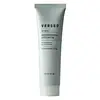What's inside
What's inside
 Key Ingredients
Key Ingredients

No key ingredients
 Benefits
Benefits

 Concerns
Concerns

 Ingredients Side-by-side
Ingredients Side-by-side

Water
Skin ConditioningMicrocrystalline Cellulose
AbsorbentHelianthus Annuus Seed Oil
EmollientCetyl Alcohol
EmollientSimmondsia Chinensis Seed Oil
EmollientGlycerin
HumectantGlyceryl Stearate
EmollientCandelilla/Jojoba/Rice Bran Polyglyceryl-3 Esters
EmulsifyingRibes Nigrum Leaf Extract
PerfumingRubus Idaeus Leaf Extract
Skin ConditioningCymbopogon Citratus Leaf Oil
MaskingMoringa Oleifera Seed Oil
EmollientArginine
MaskingHydroxyacetophenone
AntioxidantXanthan Gum
EmulsifyingCetearyl Alcohol
EmollientSodium Stearoyl Lactylate
EmulsifyingLauryl Glucoside
CleansingPhenoxyethanol
PreservativeEthylhexylglycerin
Skin ConditioningSorbic Acid
PreservativeCitral
PerfumingWater, Microcrystalline Cellulose, Helianthus Annuus Seed Oil, Cetyl Alcohol, Simmondsia Chinensis Seed Oil, Glycerin, Glyceryl Stearate, Candelilla/Jojoba/Rice Bran Polyglyceryl-3 Esters, Ribes Nigrum Leaf Extract, Rubus Idaeus Leaf Extract, Cymbopogon Citratus Leaf Oil, Moringa Oleifera Seed Oil, Arginine, Hydroxyacetophenone, Xanthan Gum, Cetearyl Alcohol, Sodium Stearoyl Lactylate, Lauryl Glucoside, Phenoxyethanol, Ethylhexylglycerin, Sorbic Acid, Citral
Water
Skin ConditioningPerlite
AbsorbentButyrospermum Parkii Butter
Skin ConditioningCaprylic/Capric Triglyceride
MaskingGlycerin
HumectantGlyceryl Stearate
EmollientAnanas Sativus Fruit Extract
Skin ConditioningCetyl Alcohol
EmollientHelianthus Annuus Seed Oil
EmollientStearyl Alcohol
EmollientRicinus Communis Seed Oil
MaskingPEG-100 Stearate
Passiflora Edulis Seed Oil
EmollientStearyl Stearate
EmollientCaprylyl Glycol
EmollientPhenoxyethanol
PreservativeCopernicia Cerifera Cera
EmollientRhus Verniciflua Peel Wax
Xanthan Gum
EmulsifyingHydrogenated Castor Oil
EmollientLimonene
PerfumingLactobacillus Ferment
Skin ConditioningTetrasodium Glutamate Diacetate
Parfum
MaskingSodium Hydroxide
BufferingCitrus Aurantium Dulcis Peel Oil
MaskingLinalool
PerfumingWater, Perlite, Butyrospermum Parkii Butter, Caprylic/Capric Triglyceride, Glycerin, Glyceryl Stearate, Ananas Sativus Fruit Extract, Cetyl Alcohol, Helianthus Annuus Seed Oil, Stearyl Alcohol, Ricinus Communis Seed Oil, PEG-100 Stearate, Passiflora Edulis Seed Oil, Stearyl Stearate, Caprylyl Glycol, Phenoxyethanol, Copernicia Cerifera Cera, Rhus Verniciflua Peel Wax, Xanthan Gum, Hydrogenated Castor Oil, Limonene, Lactobacillus Ferment, Tetrasodium Glutamate Diacetate, Parfum, Sodium Hydroxide, Citrus Aurantium Dulcis Peel Oil, Linalool
Ingredients Explained
These ingredients are found in both products.
Ingredients higher up in an ingredient list are typically present in a larger amount.
Cetyl Alcohol is a fatty alcohol. Fatty Alcohols are most often used as an emollient or to thicken a product.
Its main roles are:
Though it has "alcohol" in the name, it is not related to denatured alcohol or ethyl alcohol.
The FDA allows products labeled "alcohol-free" to have fatty alcohols.
Learn more about Cetyl AlcoholGlycerin is already naturally found in your skin. It helps moisturize and protect your skin.
A study from 2016 found glycerin to be more effective as a humectant than AHAs and hyaluronic acid.
As a humectant, it helps the skin stay hydrated by pulling moisture to your skin. The low molecular weight of glycerin allows it to pull moisture into the deeper layers of your skin.
Hydrated skin improves your skin barrier; Your skin barrier helps protect against irritants and bacteria.
Glycerin has also been found to have antimicrobial and antiviral properties. Due to these properties, glycerin is often used in wound and burn treatments.
In cosmetics, glycerin is usually derived from plants such as soybean or palm. However, it can also be sourced from animals, such as tallow or animal fat.
This ingredient is organic, colorless, odorless, and non-toxic.
Glycerin is the name for this ingredient in American English. British English uses Glycerol/Glycerine.
Learn more about GlycerinGlyceryl Stearate is a mix of glycerin and stearic acid.
It is used to stabilize the mixing of water and oil ingredients. By preventing these ingredients from separating, it can help elongate shelf life. It can also help thicken the product's texture.
As an emollient, it helps soften skin and supports barrier-replenishing ingredients.
In cosmetics, Glyceryl Stearate is often made from vegetable oils or synthetically produced.
This ingredient may not be fungal-acne safe
Fun fact: The human body also creates Glyceryl Stearate naturally.
Learn more about Glyceryl StearateHelianthus Annuus Seed Oil is the oil derived from the seeds of a Sunflower. Sunflower seed oil is non-fragrant. It is an emollient, meaning it helps to soften the skin.
Sunflower seed oil contains many fatty acids. The fatty acids found in sunflower seeds include (from highest amount to least): linoleic acid, myristic acid, palmitic acid, stearic acid, arachidic acid, oleic acid, and linolenic acid.
These fatty acids help the skin create ceramides. Ceramides play a role in repairing the skin barrier.
Helianthus Annuus Seed Oil helps moisturize the skin. This in turn helps the skin look more rejuvenated and smoother.
Sunflowers are rich in vitamin E.
Historians believe Indigenous cultures of North America domesticated sunflowers before corn. Thus they relied on sunflower oil for a variety of uses. One such use is moisturizing skin and hair.
Sunflower seed oil may not be fungal acne safe. We recommend speaking with a professional if you have any concerns.
Learn more about Helianthus Annuus Seed OilPhenoxyethanol is a preservative that has germicide, antimicrobial, and aromatic properties. Studies show that phenoxyethanol can prevent microbial growth. By itself, it has a scent that is similar to that of a rose.
It's often used in formulations along with Caprylyl Glycol to preserve the shelf life of products.
Water. It's the most common cosmetic ingredient of all. You'll usually see it at the top of ingredient lists, meaning that it makes up the largest part of the product.
So why is it so popular? Water most often acts as a solvent - this means that it helps dissolve other ingredients into the formulation.
You'll also recognize water as that liquid we all need to stay alive. If you see this, drink a glass of water. Stay hydrated!
Learn more about WaterXanthan gum is used as a stabilizer and thickener within cosmetic products. It helps give products a sticky, thick feeling - preventing them from being too runny.
On the technical side of things, xanthan gum is a polysaccharide - a combination consisting of multiple sugar molecules bonded together.
Xanthan gum is a pretty common and great ingredient. It is a natural, non-toxic, non-irritating ingredient that is also commonly used in food products.
Learn more about Xanthan Gum